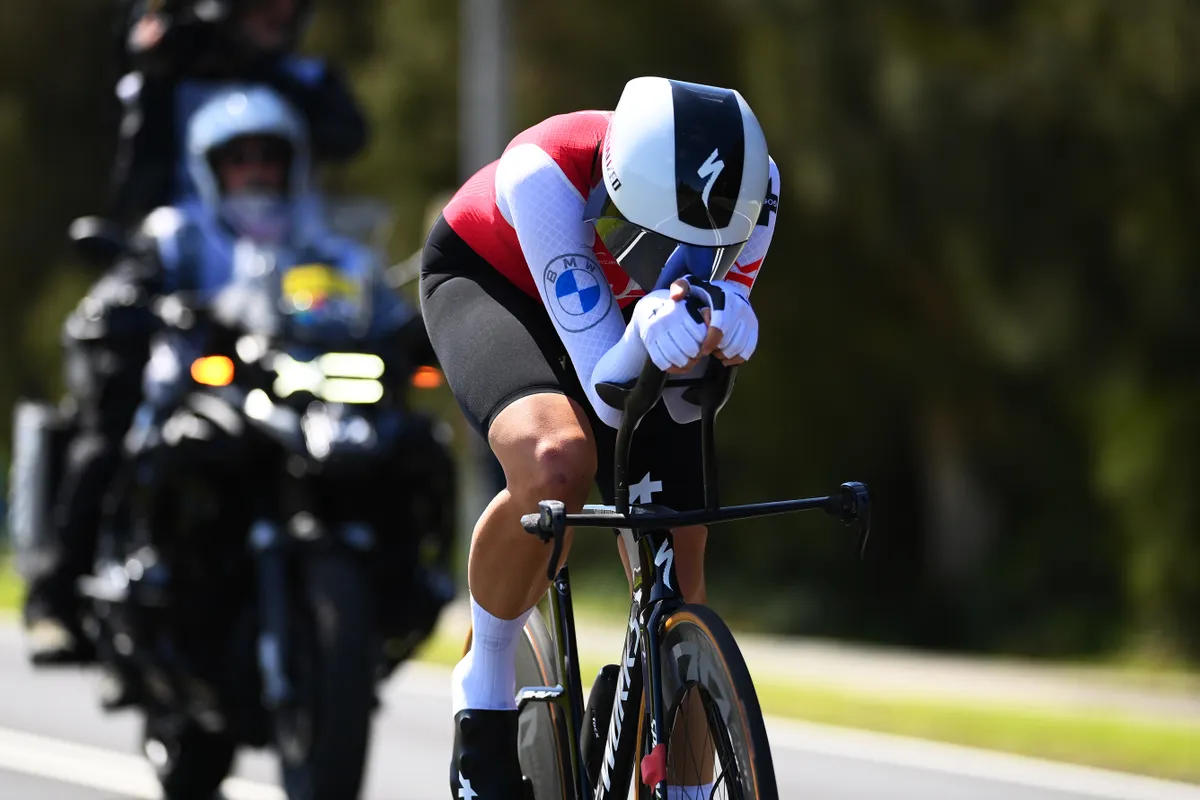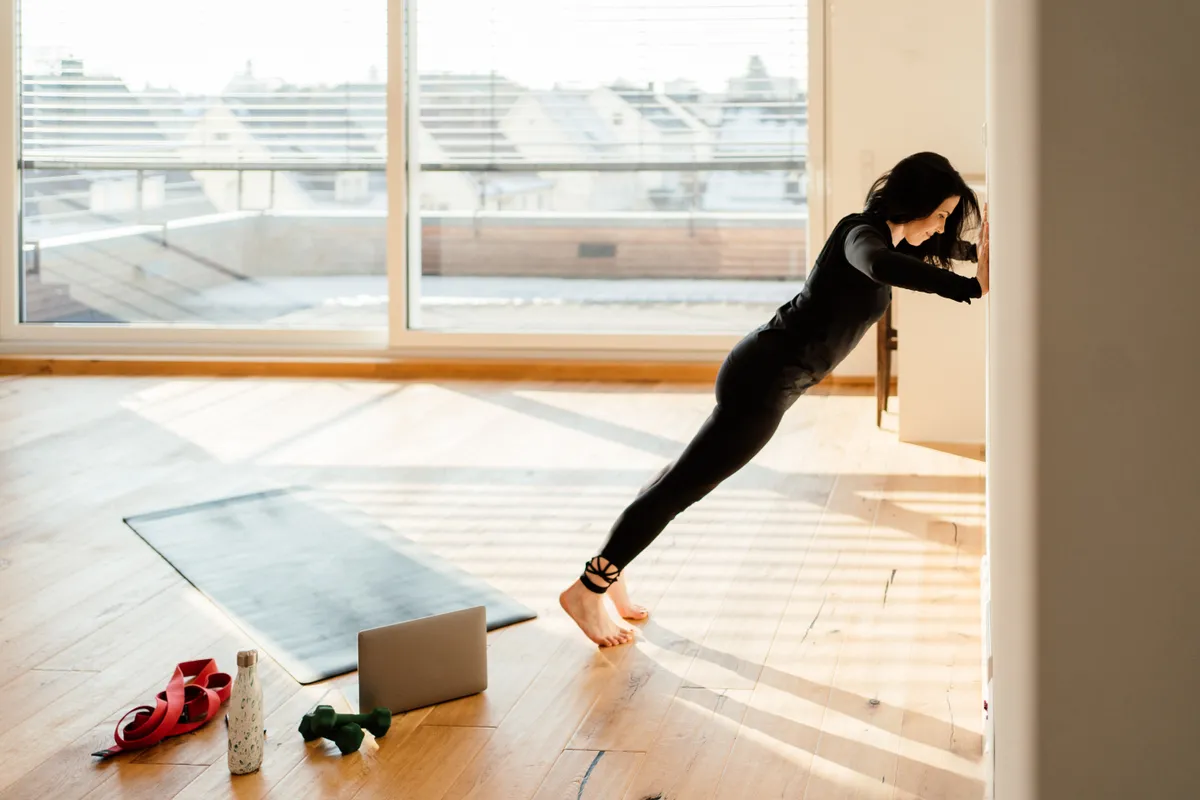Many cyclists suffer from neck pain while cycling. This is both uncomfortable and can force you into a more upright, and less efficient, riding position.
Neck pain from cycling also prevents you from looking to your rear and side while riding, potentially making you less safe on the road.
Really bad cycling neck pain can cause referred pain elsewhere. It can even cause the neck, shoulder and upper-back area to go into spasm.
The good news is, as with the most common causes of pain caused by cycling, there are simple solutions to neck pain while cycling.
You can also take preventative measures to avoid cycling neck pain, such as correcting your road bike position, regular stretching and strength training for cycling, or a combination of all three.
What causes neck pain when cycling?

Paul Hough, sport and exercise scientist at Oxford Brookes University, says the origin of neck pain from cycling is the inherent inflexibility of the thoracic spine region – otherwise known as the upper and middle back.
“The thoracic spine region is typically very stable as it encases the vital internal organs and enables us to stand upright,” says Hough. “Therefore, the thoracic spine has a limited range of movement.”
Hunching over the handlebars – and sitting at a desk – flexes the upper back and rolls back the shoulders.

Hough adds: "Road cycling involves extended periods where the neck is hyperextended (tilted backwards), particularly when the bike is set up with a large handlebar drop, when riding a time trial, for example.
"This position can cause the deep neck extensors to become fatigued and stiff.
"When this occurs, the trapezius muscle, which originates from the base of the skull to the shoulder, begins to support the weight of the head.
“Over time, this posture causes the upper back to become stiff, painful and weak – causing tightness or pain in the upper chest, shoulders and neck.”
GP and cyclist Andy Ward also blames cycling neck pain on “poor posture and bike setup”.
Ward says: “An aggressive riding position can lead to excessive extension (craning) of the neck to see down the road.
“This leads to fatigue in the muscles that stabilise the head, causing pain.”
How to stop neck pain when cycling
Changing your cycling position is often the quickest way to combat neck pain from cycling. There are a number of ways to do this.
Find a bike that fits

Bike fitters and physios say a proper bike fit is critical to prevent neck pain from cycling.
But the world’s best fitter can’t help if your road bike sizing or mountain bike sizing is miles off.
So make sure your frame size is right and go from there.
Adjust handlebar reach

Reach is the horizontal distance between two imaginary vertical lines drawn through the top of the head tube and bottom bracket axle. This measurement is fixed and is determined by the size of your bike.
Handlebar reach, however, is adjustable. This is the distance between the bottom bracket axle and the centre of the handlebar clamp.
Handlebar reach determines how far you have to lean forward to hold a handlebar’s hoods, tops or drops.
If the handlebar reach on your bike is too long you can find yourself overreaching and straining your neck in the process.

You can change handlebar reach by selecting a shorter stem. Road or gravel riders can switch to a a compact drop handlebar with shorter reach. Flat-bar riders can also switch to a shorter stem or buy a bar with more backsweep.
WorldTour bikes often feature a long stem to increase reach in order to help pros adopt an aero position.
For amateurs like us without the strength or flexibility for such aggressive riding styles, Ward cautions against a drawn-out position that places excessive strain on the neck.
Running your saddle too high can cause you to overreach, so knowing how to get your saddle height right can also prevent cycling neck pain.
Adjust handlebar height

Ward doesn’t advocate slamming the stem – as some pros do – which lowers the height of the handlebars.
If you’re experiencing neck pain when cycling, he advises adding spacers beneath the stem or flipping it to adjust handlebar height.
You may find you can’t get your stem high enough to be comfortable and this can be a sign that your bike frame is too small.
If the steerer tube on your bike has been cut and you can’t add any more spacers under the stem, you may have to purchase a new fork. Alternatively, you could buy a steerer tube extender.
Other factors that can cause neck pain while cycling

Neck and shoulder pain often come together, so physio Steven Berkman recommends keeping your shoulders relaxed in your cycling position.
“To prevent ‘pinched’ nerves around the shoulders keep your chin tucked in and the back of your neck long, with your shoulder blades down (depressed) and backwards (retracted),” says Berkman.
Hough advises always keeping your elbows slightly bent because this places less stress on the neck and shoulders.

Ward says you shouldn’t spend prolonged time in any one position: “During a ride, vary your position between the tops, hoods and drops and consider a compact drop bar.”
Ill-fitting road bike helmets and cycling glasses have the potential to exacerbate neck pain from cycling.
Ward says: “A helmet worn too far forward or glasses that slip down your nose can also cause this issue as you raise your head to avoid the obstruction to your vision.
“Check your helmet fit – if you spend a lot of time on the drops, wear it slightly pushed back.”
However, make sure your helmet isn’t pushed too far back because you still need your helmet to fit properly to be safe.
Exercises to reduce neck pain from cycling

Stretching and strengthening exercises can help mitigate cycling neck pain, as well as benefitting any areas weakened by having a tight neck.
Sports therapist Jamie Webb says: “Keeping aero but maintaining an eye on the road can put a strain on the neck and shoulders, which has a knock-on effect on your hamstring length and glute strength.”
To stretch your neck, he suggests standing and bowing your head while applying pressure with your hand downwards.

He adds: “You should feel a stretch at the back of your neck, spreading lower down your back.
“Hold for about a minute and repeat a couple of times.”
According to Ward, combining heat and stretching can work wonders.
“Standing under a hot shower and performing gentle neck stretches – tucking your chin towards your chest to feel a gentle pull and twisting the head from side to side should alleviate any aches," he says.
Do thoracic spine mobility exercises (suggested exercises are below) before and after long rides, says Paul Hough.
“Also, break up any prolonged periods of sitting with mobility exercises or simply by stretching your hands above and behind your head,” he adds.
The sport and exercise scientist advocates performing strengthening exercises of the posterior shoulders and supporting upper-back muscles, such as dumbbell rows, at least twice per week.

Physio Andy Curtis says doing core exercises and building a better back for cycling can counter neck pain from cycling, while improving your pedalling efficiency.
He says: “The ‘on-bike’ posture of the shoulder and hips being at 90 degrees – in relation to the trunk of the body – can cause postural fatigue.
“In order for the cyclist to produce power in this position, they are required to be able to dissociate their hips while maintaining a stable core through their pelvis and trunk.
“You can aid this with core stability training and scapular strengthening exercises to prevent neck and mid-back pain, while helping to maximise performance by producing a strong trunk to drive the hips from.”
Neck strengthening and stretching exercises
Alongside the stretches and strengthening exercises suggested by Webb, Hough and Curtis, these exercises can help minimise neck pain when cycling.
Thoracic spine mobility exercises

Shoulder rolls
Carry out this exercise regularly to release the tension from the muscles around your shoulders and neck.
Stand tall and relaxed with your head in line with your spine, arms hanging by your sides.
Lift your shoulders towards your ears and slowly roll them back, squeezing your shoulder blades as you lower to the starting position.
Do two, slow sets of 10.
Head turns
Drop your left shoulder and tuck your chin into your chest.
Slowly bend your head to the right, reach your right arm over your head and gently pull your head to the right.
Maintain the side bend and rotate your chin gradually to the right, until you feel the stretch.
This will help stretch and release tension from the muscle that sits at the side and toward the back of your neck.
Repeat on the left for two stretches on each side.
Neck flexes
Strengthening the muscles in your neck will make them more resistant to fatigue.
Lie flat on your back on the floor, with your head on a pillow to make it more comfortable.
Slowly, to the count of five, flex your neck until your chin reaches your chest.
Lower your head to the pillow just as slowly, taking another five seconds to return, repeating for two sets of 10
Upright row

Stand up straight and hold a 1kg dumbbell in each hand.
Rest them on the front of your thighs with your palms facing inwards.
Lift the dumbbells to your chest while keeping them close to your body and bending your elbows.
Your upper arms should end up angled slightly upwards.
Then slowly lower them again and do three sets of 20 reps, with a 30-second rest in between.
Shoulder blade wall press

Stand just over an arm’s length from a wall with your neck and back straight.
Stretch out your arms until your palms are flat to the wall then lean forward so you’re resting on the wall.
With a straight back, slowly bring your shoulder blades towards the wall so your reach lengthens.
Hold for 5 seconds, then push them back and squeeze them together.
Repeat 10 times daily to build up strength between the shoulder blades.
Back extension

Lie on the floor on your front with your legs together.
Lift your head then look up and and hold your fingertips against your temples.
Keep your elbows off the floor.
Slowly arch up your back, peeling your chest and your upper abdomen off the floor.
Pause momentarily in the ‘up’ position before lowering slowly to the floor.
Do 10 to 15 slow and steady reps.
Cat pose

Start on all fours then clench your abs, obtaining that ‘flattened’ feeling.
Arch your back up towards the ceiling and hold the arched position for a count of two.
Bow down by hollowing your back, imagining the rope is now pulling you down.
Hold the bowed position for a count of two and return to the start position.
Perform 10 to 15 reps in a controlled fashion.
